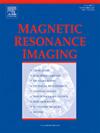Blood‐oxygenation-level-dependent (BOLD) MRI responses to CO2 and O2 inhalation in brain gliomas
IF 2.1
4区 医学
Q2 RADIOLOGY, NUCLEAR MEDICINE & MEDICAL IMAGING
引用次数: 0
Abstract
Purpose
Cerebrovascular abnormalities are intricately involved in gliomas. While static cerebrovascular properties such as cerebral blood flow, volume, and permeability have been extensively studied, dynamic vascular parameters have not been fully understood. This study aimed to characterize the vascular responses to CO2 and O2 inhalation in brain gliomas.
Methods
In 15 glioma patients, concomitant CO2 and O2 inhalation was applied while BOLD MR images were continuously acquired for nine minutes, resulting in the measurement of O2-reactivity, CO2-reactivity, and bolus arrival time (BAT). Vascular parameters were compared between the tumor regions and contralateral healthy tissue using Student t-tests. The dependence of vascular parameters on glioma grade, glioma subtypes, and molecular biomarkers were assessed using a multiple linear regression.
Results
Visual inspection suggested that reliable O2-reactivity, CO2-reactivity, and BAT maps could be obtained in every patient. Compared to the contralateral healthy tissue, glioma regions on average revealed a diminished O2-reactivity (p < 0.001) and CO2-reactivity (p < 0.001), but a lengthened BAT (p < 0.001). Intra-tumoral heterogeneity in the vascular parameters between core and periphery was also observed. Astrocytomas had a lower CO2-reactivity (p = 0.014) and a longer BAT (p = 0.012) relative to oligodendrogliomas. Glioma grade had no association with O2-reactivity, CO2-reactivity, or BAT. Patients who lost ATRX expression had a lower CO2- and O2-reactivity (p = 0.005 and p = 0.035) compared to patients who retained ATRX expression.
Conclusions
Gliomas are associated with abnormal CO2- and O2-reactivity measured with MRI. These dynamic parameters may provide new insights into the vascular pathophysiology in gliomas.
脑胶质瘤患者血氧水平依赖(BOLD) MRI对CO2和O2吸入的反应。
目的:脑胶质瘤与脑血管异常的关系错综复杂。虽然静态脑血管特性,如脑血流量、容量和通透性已被广泛研究,但动态血管参数尚未完全了解。本研究旨在描述脑胶质瘤对CO2和O2吸入的血管反应。方法:15例胶质瘤患者同时吸入CO2和O2,同时连续获取9分钟的BOLD MR图像,测量O2反应性、CO2反应性和丸到时间(BAT)。使用学生t检验比较肿瘤区域和对侧健康组织的血管参数。血管参数对胶质瘤分级、胶质瘤亚型和分子生物标志物的依赖性使用多元线性回归进行评估。结果:目测显示每位患者均可获得可靠的o2反应性、co2反应性和BAT图。与对侧健康组织相比,相对于少突胶质细胞瘤,胶质瘤区域的平均o2反应性(p 2-反应性(p 2-反应性(p = 0.014))降低,BAT更长(p = 0.012)。胶质瘤分级与o2反应性、co2反应性或BAT无关。与保留ATRX表达的患者相比,失去ATRX表达的患者具有较低的CO2和o2反应性(p = 0.005和p = 0.035)。结论:胶质瘤与MRI测量的异常CO2和o2反应性有关。这些动态参数可能为胶质瘤的血管病理生理学提供新的见解。
本文章由计算机程序翻译,如有差异,请以英文原文为准。
求助全文
约1分钟内获得全文
求助全文
来源期刊

Magnetic resonance imaging
医学-核医学
CiteScore
4.70
自引率
4.00%
发文量
194
审稿时长
83 days
期刊介绍:
Magnetic Resonance Imaging (MRI) is the first international multidisciplinary journal encompassing physical, life, and clinical science investigations as they relate to the development and use of magnetic resonance imaging. MRI is dedicated to both basic research, technological innovation and applications, providing a single forum for communication among radiologists, physicists, chemists, biochemists, biologists, engineers, internists, pathologists, physiologists, computer scientists, and mathematicians.
 求助内容:
求助内容: 应助结果提醒方式:
应助结果提醒方式:


